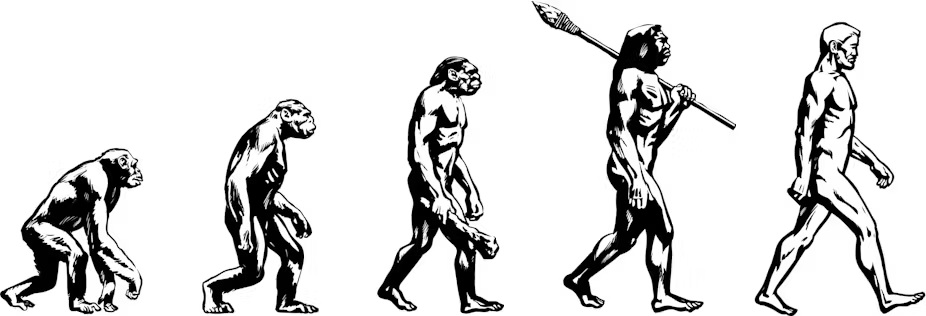Since some have asked recently about my thoughts on evolution I will attempt to answer those questions…
First, let’s address the elephant in the room: Do I believe in evolution? Absolutely. The fossil record serves as a remarkable testament to the Earth’s ever-changing tapestry of life. We see undeniable evidence of species adapting and diversifying over vast stretches of time. The peppered moth’s industrial camouflage response to pollution is a potent example of evolution in action, even within our own lifetimes. This is an example of change over time. However, in order to understand my position on evolution we must define what I mean by evolution. There are at least six definitions that could apply to the term “evolution.” These consist of:
- Change over time; history of nature; any sequence of events in nature.
- Changes in the frequencies of alleles in the gene pool of a population.
- Limited common descent: the idea that particular groups of organisms have descended from a common ancestor.
- The mechanisms responsible for the change required to produce limited descent with modification, chiefly natural selection acting on random variations or mutations.
- Universal common descent: the idea that all organisms have descended from a single common ancestor.
- “Blind watchmaker” thesis: the idea that all organisms have descended from common ancestors solely through an unguided, unintelligent, purposeless, material processes such as natural selection acting on random variations or mutations; that the mechanisms of natural selection, random variation and mutation, and perhaps other similarly naturalistic mechanisms, are completely sufficient to account for the appearance of design in living organisms.
When I speak of evolution I refer not the fact that species evolve over time. This is very well established in the fossil record. I refer to the mechanism that causes this phenomenon. I have serious concerns and disagreements about the idea that random mutation can bring about the change required. The dominant theory, Neo-Darwinism, proposes that random mutations in an organism’s DNA, coupled with natural selection, are the driving forces behind change. Natural selection, as Charles Darwin famously described, favors traits that enhance survival and reproduction. Over generations, these advantageous traits become more prevalent within a population, leading to gradual change.
Here’s where things get interesting. Neo-Darwinism often invokes the vast expanse of time, billions of years, as a silent ally. The argument goes: with enough time, random mutations could theoretically generate any conceivable variation. But here’s a thought experiment to consider:
Imagine searching for a specific, incredibly valuable diamond ring within a chaotic, overflowing warehouse. This warehouse represents the vast “sequence space” of all possible combinations of building blocks (amino acids) that make up proteins, the workhorses of life. Finding a functional protein through random mutations alone becomes akin to locating that specific diamond ring – an improbable feat.
Why is this a problem? Because studies suggest the vast majority of protein sequences are non-functional. Think of a simple bike lock with four dials, each offering ten digits. There are 10,000 possible combinations, but only one unlocks the bike. Now, imagine a protein sequence with hundreds or even thousands of “dials.” The number of possible arrangements grows exponentially, creating an astronomical haystack of possibilities.
The odds of randomly stumbling upon a functional protein within this massive space seem incredibly low. This is the essence of the “haystack problem” in evolution. It suggests that random mutations alone might not be sufficient to explain the origin of complex biological features. One recent experimentally derived estimate places that ratio—the size of the haystack in relation to the needle—at 1077non-functional sequences for every functional gene or protein. (There are only something like 1065 atoms in our galaxy.)
This is one reason why I am highly skeptical of random mutation as the mechanism for change. However, there is another reason, that is information.
In 1953, Watson and Crick unraveled a revolutionary secret: the structure of DNA. This molecule acts as a blueprint, storing life’s information in a surprisingly simple way – a four-letter code. Like letters in a language, specific sequences of chemicals called bases encode instructions for building proteins, the workhorses of the cell.
Expanding on this idea, Francis Crick proposed the “sequence hypothesis.” Just as word order dictates meaning in a sentence, the order of these bases determines the protein produced. This arrangement, like written language, reflects a fundamental property – “sequence specificity.” Information isn’t just stored, it’s precisely encoded.
But DNA goes beyond mere “information” in the mathematical sense. Information theorist Claude Shannon measured information by its improbability. DNA, however, doesn’t just hold improbable sequences; it holds instructions that have a specific effect – building proteins! It possesses “specified” or “functional information.”
Imagine a computer program. Zeros and ones arranged in a specific way create instructions. Similarly, the bases in DNA, following a specific code, convey instructions for building life’s machinery. This code is so sophisticated that biologists like Richard Dawkins compare it to a computer program, while others like Bill Gates consider it far more advanced.
Further discoveries revealed that DNA and RNA form a complex information processing system, a form of nanotechnology surpassing our own in design and storage density. But a crucial question remains: where did this information come from?
The sheer amount of information in a cell simply can’t be explained by random chance. Attempts to explain it through pre-biotic natural selection require pre-existing information itself – a circular argument. The laws of chemistry alone can’t explain it either. Imagine a newspaper headline spontaneously forming from ink and paper!
Something more fundamental is at play. No theory of random chemical evolution adequately explains the origin of the information needed for the first living cell. This information appears designed, a mystery that continues to challenge our understanding of life’s origins.
This doesn’t negate evolution itself! It simply suggests there might be more to the story. Perhaps there are undiscovered mechanisms at play, or maybe our understanding of mutation and natural selection needs further refinement.





